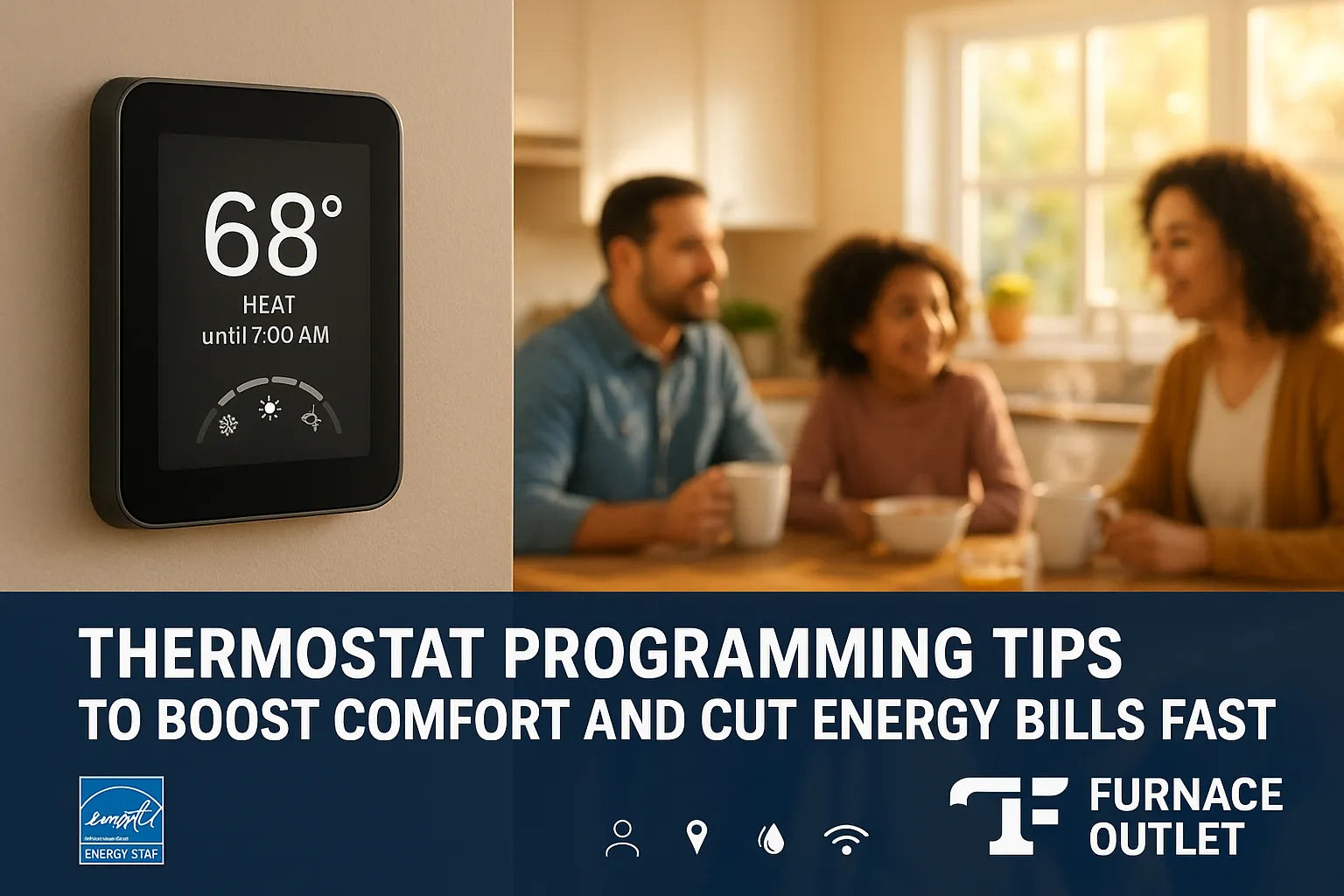Waking Up Cold? The Breakfast Table Thermostat Story
It’s 6:45 AM, Saturday. You shuffle into the kitchen, hoping for warm coffee—and instead meet an icy draft. Last night you meant to lower the heat to save money, but you forgot to bring it back up before sunrise.
Sound familiar? With smart thermostat programming, that jolt of cold disappears. Your system heats the house before your feet hit the floor, trims energy when no one’s home, and still keeps bills in check.
What Exactly Is Thermostat Programming, Anyway?
Think of programming as teaching your thermostat a daily story: when you’re home, how you like each room, and why the schedule may change on weekends. Modern units store dozens of set points and even adjust themselves with machine learning. Proper thermostat programming cuts heating and cooling waste by 10–15 percent, according to the U.S. Department of Energy.
Older dial models? They stay at one temperature—no nuance, no savings. Yet swapping to a smart model costs less than many single heater repairs, especially when you grab factory‑fresh gear straight from our accessories aisle.
The Science of Comfort: Ideal Temps for Every Season
Below is a glance table our techs reference on calls. It mirrors Energy Star guidance and keeps math simple:
|
Season |
Home & Awake |
Sleeping/Away |
Energy‑Agency Backing |
|
Winter |
68 °F (20 °C) |
60–65 °F (15–18 °C) |
|
|
Summer |
78 °F (25 °C) |
82–85 °F (28–29 °C) |
Notice the 7‑degree swing? That gap is the sweet spot where comfort meets low utility bills. The moment your household schedule shifts, such as during summer break, the settings should shift too. Thankfully, smart thermostats learn those changes faster than you can say “design a system for me.”
Building a Schedule That Fits Your Life
Start with a pencil and a notepad. List wake‑up, leave, return, and bedtime for each day. Families often discover unused weekday hours when every room sits empty. Next, enter those slots into the thermostat app. Pro tip: Set heat or cooling changes 20 minutes before the actual event so rooms feel right on time. Many models offer “copy to all weekdays” to speed things up. If your agenda swings, enable geofencing. It monitors your phone’s GPS, automatically switching the system into eco mode once you've driven away.
Still unsure? Chat live with our team or browse the help center articles for step-by-step guides with GIFs.
Harnessing Smart Features for Hands‑Off Savings
Today’s thermostats pack AI, motion sensors, and weather forecasting:
-
Learning Mode: Tracks manual tweaks; after a week, it adjusts automatically.
-
Geofence: Detects when the last phone leaves home.
-
Humidity Assist: Coordinates with compatible air handlers to maintain ideal moisture.
-
Over-the-Air Updates: Adds new algorithms without requiring hardware swaps, much like a smartphone.
Fine‑Tuning for Winter: Cozy Without the Cost
When outside temps nosedive, resist cranking the furnace all day. Instead, set a two‑stage ramp: 68 °F during waking hours, 62 °F overnight. Let blankets do the rest. If you own a dual‑fuel packaged unit, balance points matter: program the heat pump down to 35 °F outdoor temp, then let gas take over. Our phone techs calculate that crossover for free—no guesswork, no chilly surprises. Pair schedules with sealed windows and clean filters, and you’ll watch kilowatt hours drop faster than snowflakes.
Staying Cool in Summer Without Blowing the Budget
Air conditioning consumes the most electricity between 2 p.m. and 7 p.m. Shift chores—such as laundry and oven baking should be done outside that window. Program the thermostat to 78°F at home and 83°F away. Ceiling fans make 78 °F feel like 74 °F by boosting evaporation. If you require zoned cooling, consider a DIY ductless mini‑split that runs only where you sit.
Combined with thoughtful thermostat programming, they can reduce peak usage by 30%, according to recent research by ASHRAE.
Troubleshooting Common Set‑Up Mistakes
-
Wrong Time Zone: A top support call. Check the clock first.
-
Thermostat Near Draft: Move it away from windows or supply vents.
-
Overlapping Set Points: Delete duplicates; the Device may default to the earlier entry.
-
“Hold” Mode Left On: Clears schedules until you press “Run.”
If your screen still appears, open a ticket in our help center or call the hotline. Ninety percent of hiccups resolve in ten minutes, saving you an unnecessary service call.
Choosing the Right Thermostat for Your System
Not all HVAC gear speaks the same language. Single-stage furnaces require basic two-wire control; variable-speed R32 condensers demand multi-terminal models with dehumidification logic. Before buying, note:
-
Furnace or heat‑pump type
-
Staging (single, two‑stage, modulating)
-
Accessory needs (humidifier, ERV, UV purifier)
Upload a photo of your control board to our design center; we’ll match a thermostat that maximizes features and stays within budget.
DIY Installation Tips and When to Call a Pro
Most replacements require:
-
Power off at the breaker.
-
Label wires with supplied stickers.
-
Mount the backplate level on the drywall anchor.
-
Scan QR code; follow app prompts.
If you encounter brittle wires or mystery jumpers, pause and phone our licensed team. Sometimes the safest route is to bundle a thermostat with a factory-configured packaged unit; wiring arrives pre-terminated, shaving hours off installation time.
Real‑World Savings: Dollars, kWh, and Planet
A 2,000 sq ft U.S. home spends $2,000 + annually on heating and cooling (DOE average). Proper programming, combined with high-efficiency equipment, reduces the figure by $300-$400. That’s equivalent to planting 200 trees in a carbon offset, according to EPA calculators.
Buying direct from The Furnace Outlet keeps more of that windfall in your wallet: wholesale pricing, fast free shipping, and ensures every penny counts.
Pair Programming with High‑Efficiency Equipment
Your thermostat can only do so much if the system behind it guzzles power. Consider upgrading to an all-in-one R32 packaged air conditioner, a whisper-quiet air handler, or even a room-by-room through-the-wall unit for tricky additions.







